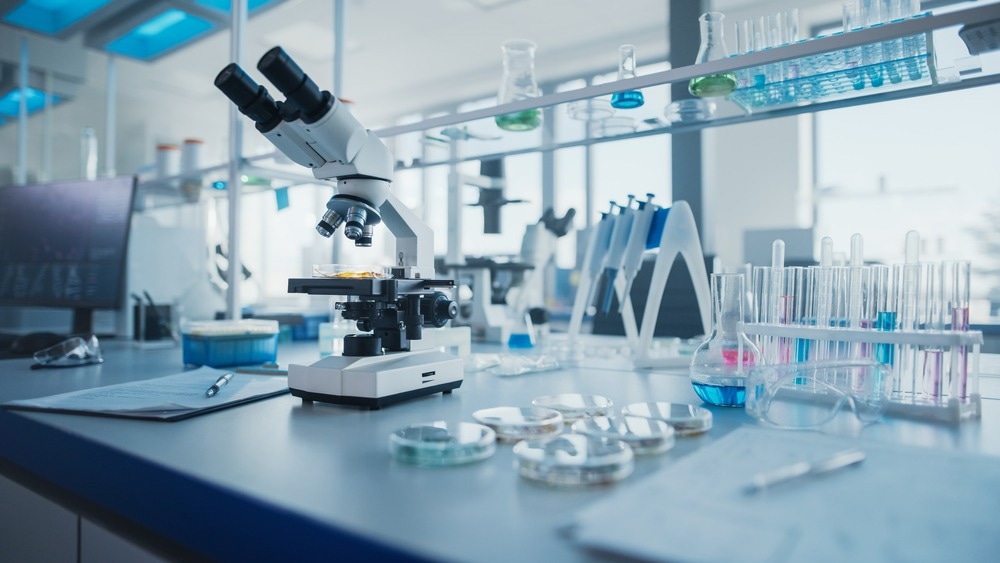Sample preparation consists of a series of operations to prepare the sample for analysis and improve the results. When selecting the preparation procedure, several factors must be considered, such as the sample characteristics, the purpose of analysis, and the choice of the analytical technique.

Image Credit: Gorodenkoff/Shutterstock.com
Sample preparation, from very basic to more complex procedures, may involve weighing solids, mixing or diluting liquids, heating, or cooling. Other preparation strategies include grinding, filtration, centrifugation, evaporation, and pH adjustment.
These operations aim to simplify the sample matrix – by eliminating chemicals that might interfere with the measurement – or concentrate the analyte of interest. In every case, sample preparation is considered as important as the analysis itself since it can often affect the observed results.
When weighing, it is important that an appropriate amount of sample is taken for the analysis. When diluting, the final product must be as homogeneous as possible. Mistakes in either of the operations can affect the sample concentration and the analysis results.
Some samples can be physically or chemically unstable and are sensitive to transformations. For instance, some volatile species may be lost when attempting to reduce the amount of solvent through evaporation. Consequently, attention must be paid to not altering the content of the analytes within the sample.
The Wrong Preparation May Lead to Inaccurate Values
The content of heavy metals in river sediments is used as a parameter to evaluate pollution levels and environmental risks. Inaccurate results of the chromium levels can cause a wrong assessment of the risk category.
It was observed that different drying procedures in the presence of atmospheric oxygen (at 20 °C and 105 °C, respectively) do not impact the chromium distribution. Conversely, grinding – reducing to powder by friction – overestimated the chromium content.
Ground samples showed two-to-seven-fold higher chromium content than the raw river sediment samples. This is probably due to differences in the kinetics of leaching in chromium fractions. Despite being less homogeneous, raw samples should be used in this specific case to have a realistic estimate of chromium levels and assess environmental risk.
Sample preparation can also have pronounced effects on the analysis of soils. For instance, the analysis via portable X-ray fluorescence (pXRF) spectroscopy may have different accuracy depending on whether it is performed on field-moist soils, dried and ground powders, or pressed pellets.
A study on soil samples collected from a river in eastern Iowa showed inconsistencies between pXRF and benchtop XRF data depending on the preparation method used.
Although there was quite a strong agreement with the data of certain elements and oxides, such as CaO, MnO, and TiO2, pXRF consistently underestimated the concentrations of SiO2 and Al2O3. The best results were obtained when soil samples were dried, ground, and pressed into pellets prior to pXRF analysis.
Sample Preparation Strategies to Reduce Matrix Effects
Isolating target analytes from other sample matrix components is one of the main goals of sample preparation. This is particularly relevant in liquid chromatography-tandem mass spectrometry (LC-MS/MS), where the sample matrix can influence the determination of the analyte if not removed prior to analysis.
For instance, pharmaceutical targets are normally present in low concentrations and require preconcentration. Proper preparation is needed to remove interfering components that can co-elute within the sample and can, therefore, either enhance or suppress the response to the analyte.
The structure and concentration of analyte and interfering co-eluants determine the competition during the ionization process. For example, Electrospray ionization (ESI) is strongly biased toward surfactants. Therefore the technique is particularly sensitive to co-eluting phospholipids that are commonly interferent in serum and plasma samples.
Various approaches can eliminate or at least reduce matrix effects in the LC-MS analysis of biofluids. A very common method is protein removal. This can be achieved by protein denaturation (i.e., with heat or acids) or removal with ultrafiltration cut-off membranes.
In the alternative, organic solvents can cause protein precipitation (PPT). Depending on the organic solvent used, PPT can remove phospholipids present in serum and plasma samples. Acetonitrile is the ideal solvent, but methanol is also quite effective.
Solid-phase extraction (SPE) is a very common method that finds a broad range of applications in quantifying small molecules in biofluids via LC-MS/MS. Cartridges packed with silica-based sorbents have exceptional retention capacity for phospholipids when eluted with acetonitrile.
There is increasing interest in using magnetic particles and nanoparticles (MNPs) for sample preparation, both in the extraction and preconcentration of analytes in complex fluids.
MNPs overcome drawbacks of the conventional adsorbent materials, such as time consumption and large volume of samples, since they are directly dispersed in the sample solutions for quick extraction of their targets and can be readily recovered by a magnet.

Image Credit: Pressmaster/Shutterstock.com
Trends and Future Directions
Several methods are available, and new approaches are developed as techniques and technologies evolve. Current challenges are directed toward the simplification and automation of preparation procedures.
Although automation can be expensive, it is advantageous to reduce analysis time when a large number of samples must be analyzed. Other developments include specificity enhancements and miniaturization, with the latter looking particularly promising thanks to the advances in nanomaterials.
An analysis's success (or failure) can lie in the choice of the right preparation procedures, no matter how basic or simple they may seem. Therefore, sample preparation should not be underestimated and should be planned as part of the overall analysis.
Sources:
- Moldoveanu, S. & David, V. (2015). The Role of Sample Preparation. 33-49.10.1016/b978-0-444-54319-6.00002-5
- Trojanowska, M. & Swietlik, R. (2019). The importance of drying and grinding samples for determining mobile chromium fractions in polluted river sediments. Environ Monit Assess, 191, 578.10.1007/s10661-019-7727-2
- Goff, K., Schaetzl, R. J., Chakraborty, S., Weindorf, D. C., Kasmerchak, C. & Bettis, E. A. (2020). Impact of sample preparation methods for characterizing the geochemistry of soils and sediments by portable X‐ray fluorescence. Soil Science Society of America Journal, 84, 131-143.10.1002/saj2.20004
- Bylda, C., Thiele, R., Kobold, U. & Volmer, D. A. (2014). Recent advances in sample preparation techniques to overcome difficulties encountered during quantitative analysis of small molecules from biofluids using LC-MS/MS. Analyst, 139, 2265-76.10.1039/c4an00094c
Further Reading
Last Updated: Dec 16, 2022